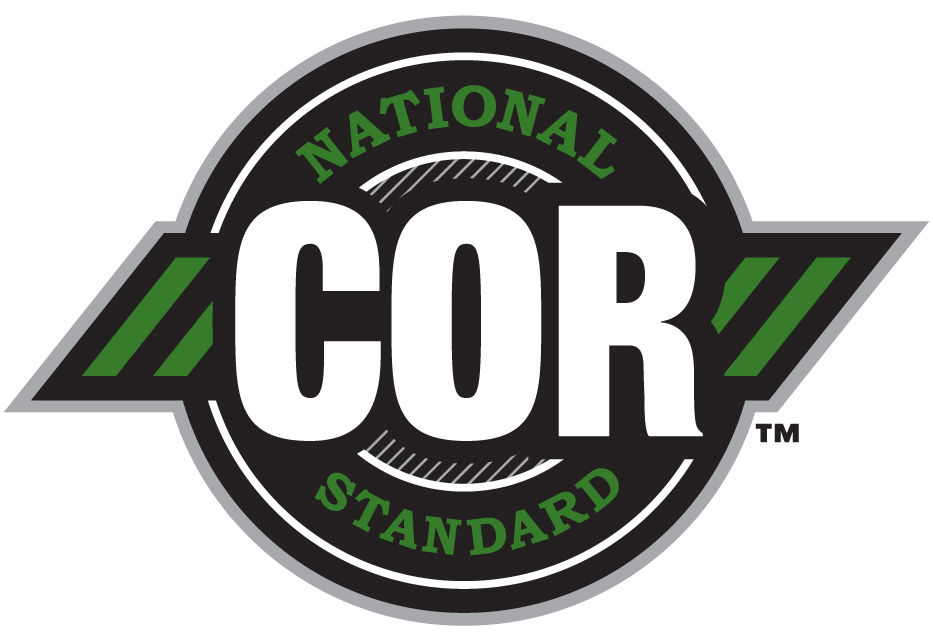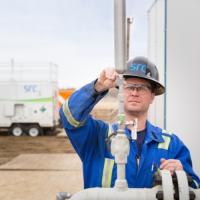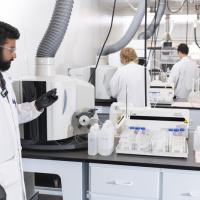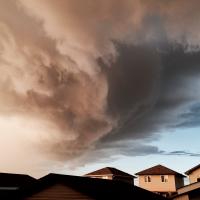SRC offers a comprehensive suite of air quality measurement, monitoring and modelling services designed to meet the needs of clients in industries such as mining, manufacturing, electricity generation and biofuels.
Our team is comprised of knowledgeable experts that can provide industrial facilities with a clear understanding of their industrial air emissions and indoor air quality performance—helping them implement emissions reduction strategies for long-term environmental and economic benefits.
SRC’s air quality team provides integrated services, from stack sampling to environmental protection plans (EPPs). Our services fall into five main categories:
- Industrial Source Testing (Stack Sampling)
- Ambient Air Monitoring – medium-term (1-18 months) or long-term (2+ years) deployments
- Environmental Protection Plans (EPPs) under the Industrial Source (Air Quality) chapter of the Saskatchewan Environmental Code
- Air Dispersion Modelling
- Industrial Hygiene (Indoor Air Quality)
Industrial Source Testing
SRC offers regulatory compliance testing and testing to support engineering and process improvements for air emissions. Clients can use the data obtained from these tests for National Pollutant Release Inventory (NPRI) reporting, air dispersion modelling data inputs, process optimization and more.
Stack Sampling
With over 45 years of stack sampling expertise, SRC’s highly trained and experienced team can:
- Sample for Particulate Matter (PM), including filterable particulate and Condensable Particulate Matter (CPM), PM10 and PM2.5 from the stack and from within the process
- Measure real-time stack concentrations of greenhouse gases (GHG) such as carbon dioxide (CO2), nitrous oxide (N2O) and methane (CH4)
- Conduct relative accuracy test audits (RATA) on Continuous Emissions Monitoring Systems (CEMS) for various pollutant gases
- Characterize air contaminants such as sulfur dioxide (SO2), nitrogen oxides (NOX), ammonia (NH3), volatile organic compounds (VOCs), hydrochloric acid (HCl) and chlorine gas (Cl2) emitted from industrial sources
- Measure semi-volatile organic species such as polycyclic aromatic hydrocarbons (PAHs), polychlorinated biphenyls (PCBs), dioxins and furans (PCDD/PCDF)
SRC can also sample high-temperature stacks (up to 1100°C).
SRC’s stack sampling service provides clients with real-time readings and time-resolved data. These fast and reliable results are recorded and logged for clients and can be used to develop process improvement strategies and EPPs.
Contact us to learn more about our stack sampling services.
Visual Opacity
Regulators set limits on how much light can be blocked by an emissions plume, which requires measuring its visual opacity.
SRC offers visual opacity testing using automated methods that increase accuracy and remove the subjective factor from traditional opacity measurements.
Continuous Emissions Monitoring System (CEMS)
CEMS are permanently installed at a facility on certain sources or stacks and run continuously year-round. CEMS can monitor gases including oxygen, carbon monoxide, carbon dioxide and nitrogen oxides released during industrial processes.
SRC provides Relative Accuracy Test Audits (RATAs) to verify a CEMS is operational, optimized and meeting its regulatory requirements and commitments in the facility’s Quality Assurance Plan. These tests can also be used to satisfy requirements for a Cylinder Gas Audit (CGA).
Trace-Level Analysis
SRC offers trace-level analysis testing for:
- Dioxins and Furans
- Polycyclic Aromatic Hydrocarbons (PAHs)
- Metals
- Mercury
- Radionuclides
- Volatile Organic Compounds (VOCs)
- Methane and Non-methane Organic Compounds (NMOCs)
- Total Hydrocarbons (THC)
Ambient Air Monitoring
Fenceline Monitoring
SRC can conduct ambient air quality monitoring at plant boundaries or within airsheds/air zones. This monitoring can be complaint-driven, research-focused or outlined in EPPs and provides clients with the data needed to optimize processes.
Mobile Ambient Air Monitoring Stations
SRC can customize and deploy temporary or long-term ambient air monitoring stations to provide clients with real-time data availability and data management for gases such as:
- Hydrogen Sulfide (H2S)
- Sulfur Dioxide (SO2)
- Nitric Oxide (NO) and Nitrogen Dioxide (NO2)
- Ozone (O3)
- Ammonia (NH3)
- Particulate Matter less than 2.5 micrometers (PM2.5)
- Wind Speed and Direction
- Ambient Temperature
- Ambient Pressure
- Relative Humidity
- Precipitation
Stations can be deployed for short-term (1-12 months) or long-term (12+ months) durations.
Regional Air Zone Management Monitoring
SRC can conduct calibrations and verifications, perform routine maintenance and gather real-time data on air quality monitoring stations located in provincial air management zones or for airshed associations.
This work contributes to more reliable and accurate data on the type and concentration of airborne pollutants in the environment, and helps health organizations and regulatory bodies to make decisions supported by scientifically defensible data.
Environmental Protection Plans (EPPs)
SRC works with clients to prepare and certify EPPs under the Industrial Source (Air Quality) (ISAQ) chapter of the Saskatchewan Environmental Code.
EPPs are used to ensure no unacceptable adverse effects to the environment or human health result from air emissions from industrial activity in the province and allow facilities to receive Approvals to Operate from the Saskatchewan Ministry of Environment.
Combining expertise in stack sampling, ambient air monitoring and air dispersion modelling, our team has experience preparing EPPs under the ISAQ chapter for a variety of industrial sources, including mine and mill sites, chemical plants, manufacturing facilities and incinerators for almost a decade.
Contact us for help with your EPP.
Air Dispersion Modelling
With air dispersion modelling, clients can simulate current ambient air concentration of pollutants and predict future potential impacts from industrial activity. These measurements can be used to determine possible environmental and human health effects, helping government and industry implement safety precautions.
Regulatory Air Dispersion Modelling (AERMOD)
Dispersion modelling is carried out using the U.S. Environmental Protection Agency’s AERMOD regulatory model and is in alignment with Saskatchewan’s Air Quality Modelling Guidelines.
These models predict potential ambient concentrations of air pollutants and compare against air quality standards. Modelling is often used to support the development of EPPs or evaluate potential air quality impacts of new (greenfield) or existing (brownfield) industrial developments or expansions.
Emergency Release Modelling
Emergency release modelling is useful to evaluate the risks associated with unintentional releases resulting from spills, pipe ruptures, tank failures, fires and more.
This modelling can support a facility’s Emergency Response Plan or be used as an assessment tool in Environmental Emergency (E2) Plans prepared for Environment and Climate Change Canada.
Industrial Hygiene (Indoor Air Quality)
SRC offers indoor air quality testing within a variety of industrial workplaces. Our tests can detect and measure inhalable particles generated by asphalt plants, coal, wood, biomass, potash and hard rock mining sectors.
These particles can be characterized for concentration and size to give clients detailed information on their indoor air quality. Particle composition (including silica content) can often be determined from the particulate sample.
SRC can also monitor:
- Combustion Gases
- Acid Gases
- Welding fumes
- Biologicals, such as mold and bacteria
Contact us for all your air quality measurement, monitoring and modelling needs.
Environmental Testing and Analysis
Field samples collected by SRC’s air quality team are sent to SRC Environmental Analytical Laboratories, which provides world-class analysis of several media types, as well as radon testing.
COR Certification
 SRC's Air Quality team is COR-certified, the industry standard in safety certification. The Certificate of Recognition (COR) certification is nationally trademarked and endorsed by participating members of the Canadian Federation of Construction Safety Associations (CFCSA).
SRC's Air Quality team is COR-certified, the industry standard in safety certification. The Certificate of Recognition (COR) certification is nationally trademarked and endorsed by participating members of the Canadian Federation of Construction Safety Associations (CFCSA).




